See also
- Titti (bagpipe), a Telugu bagpipe of Andhra Pradesh
- Sruti upanga, a drone bagpipe of Tamil Nadu
The mashak (also known as mushak baja, masak, mishek, meshek, moshug, moshaq, moshuq, mashak bin, bin baji) is a type of bagpipe found in Northern India, Uttarakhand, Sudurpaschim Province (especially Baitadi and Darchula district) of Nepal and parts of Pakistan and Afghanistan. [1] [2] The pipe was associated with weddings and festive occasions. [3] In India it is historically found in Garhwal (kumaon) in Uttarakhand, Rajasthan and Uttar Pradesh. [4] This bagpipe uses single reeds, [5] and can be played either as a drone or as a melody instrument. [6]
The etymology of the term mashak stems from its common use in India, referring to a skin bag used for carrying water. This skin bag shares a similar function to the air bag of the bag pipes. [7]
Some academics dispute any indigenous origins of the mashak; researcher Ander Burton Alter wrote in 2000 that the pipes today played in Kumaon are Scottish Highland bagpipes with one bass and two tenor drones, with no local manufacturer or evidence of existence prior to British rule in 1814. [8] Organologist Anthony Baines, however, described an intermediary development stage wherein Indian musicians imitated the Highland pipe by tying "an extra pipe or two" into their mashak. [9] Similarly, the New Grove Dictionary of Musical Instruments (1984) describes the traditional mashak as becoming rare as it is displaced by the Scottish pipes. [10]
The Garhwali bagpipe is the name to which the Garhwali people of Northern India have given the masak baja. [11] [12]
In the central Himalayan region of Garhwal in Northern India the masak baja is an important part of rural wedding ceremonies. The masak baja is played to process with the groom's on their way to and from the bride's village. [13] The masak is accompanied by two pipers and drummers. The masak and its accompanying instruments send a clear message across the audible area that a wedding is taking place.

Bagpipes are a woodwind instrument using enclosed reeds fed from a constant reservoir of air in the form of a bag. The Scottish Great Highland bagpipes are the best known examples in the Anglophone world, but people have played bagpipes for centuries throughout large parts of Europe, Northern Africa, Western Asia, around the Persian Gulf and northern parts of South Asia.

The uilleann pipes are the characteristic national bagpipe of Ireland. Earlier known in English as "union pipes", their current name is a partial translation of the Irish language terms píobaí uilleann, from their method of inflation. There is no historical record of the name or use of the term uilleann pipes before the 20th century. It was an invention of Grattan Flood and the name stuck. People mistook the term 'union' to refer to the 1800 Act of Union; this is incorrect as Breandán Breathnach points out that a poem published in 1796 uses the term 'union'.

The chanter is the part of the bagpipe upon which the player creates the melody. It consists of a number of finger-holes, and in its simpler forms looks similar to a recorder. On more elaborate bagpipes, such as the Northumbrian bagpipes or the Uilleann pipes, it also may have a number of keys, to increase the instrument's range and/or the number of keys it can play in. Like the rest of the bagpipe, they are often decorated with a variety of substances, including metal (silver/nickel/gold/brass), bone, ivory, or plastic mountings.

The Great Highland bagpipe is a type of bagpipe native to Scotland, and the Scottish analogue to the Great Irish Warpipes. It has acquired widespread recognition through its usage in the British military and in pipe bands throughout the world.
The border pipes are a type of bagpipe related to the Scottish Great Highland Bagpipe. It is perhaps confusable with the Scottish smallpipe, although it is a quite different and much older instrument. Although most modern Border pipes are closely modelled on similar historic instruments, the modern Scottish smallpipes are a modern reinvention, inspired by historic instruments but largely based on Northumbrian smallpipes in their construction.

The folk music of Uttarakhand refers to the traditional and contemporary songs of Kumaon and Garhwal regions in the foothills of Himalayas. This music has its root in the lap of nature and the hilly terrain of the region.
The bhankora is a type of trumpet made of copper that is prominently used in the folk music of Uttarakhand in India, especially in the Garhwal region. The instrument is aerophonic and used specifically in religious Garhwal Folk Dramas, most notably the Pandav Lila and Nanda Devi Raj Jat. The instrument is played only by upper class Garhwalis during the Naubat, Dhanyal, and Dev Jatra types of religious ritual performances. The bhankora is made of copper and is about 36 inches long and about 3 inches in diameter; it creates a sweet melodious sound and tone.
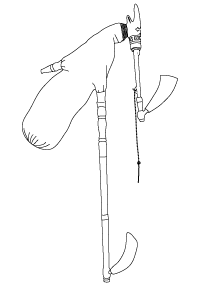
The Hungarian duda is the traditional bagpipe of Hungary. It is an example of a group of bagpipes called Medio-Carparthian bagpipes.
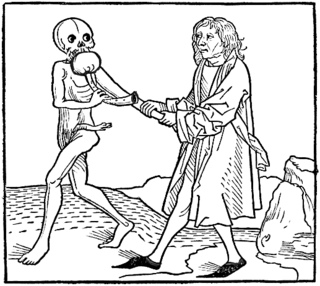
The Bladder pipe is a medieval simplified bagpipe, consisting of an insufflation tube, a bladder (bag) and a chanter; sounded by a double reed, which is fitted into a reed seat at the top of the chanter. The reed, inside the inflated bladder, is sounded continuously, and cannot be tongued. Some bladder pipes were made with a single drone pipe, and reproductions are similar to a loud, continuous crumhorn. The chanter has an outside tenon, at the top, near the reed, which fits into a socket or stock, which is then tied into the bladder.

Welsh bagpipes The names in Welsh refer specifically to a bagpipe. A related instrument is one type of bagpipe chanter, which when played without the bag and drone is called a pibgorn (English:hornpipe). The generic term pibau (pipes) which covers all woodwind instruments is also used. They have been played, documented, represented and described in Wales since the fourteenth century. A piper in Welsh is called a pibydd or a pibgodwr.
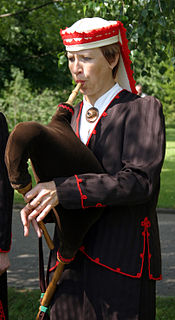
The torupill is a traditional bagpipe from Estonia.
This article defines a number of terms that are exclusive, or whose meaning is exclusive, to piping and pipers.
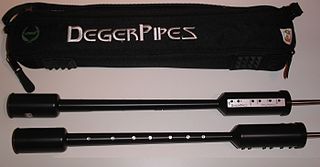
The electronic bagpipes is an electronic musical instrument emulating the tone and/or playing style of the bagpipes. Most electronic bagpipe emulators feature a simulated chanter, which is used to play the melody. Some models also produce a harmonizing drone(s). Some variants employ a simulated bag, wherein the player's pressure on the bag activates a switch maintaining a constant tone. As with other electronic musical instruments, they must be plugged into an instrument amplifier and loudspeaker to hear the sound. Some electronic bagpipes are MIDI controllers that can be plugged into a synth module to create synthesized or sampled bagpipe sounds.
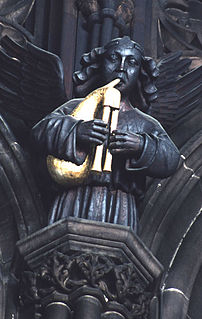
When bagpipes arrived in England is unknown, there is some evidence to suggest Anglo-Saxon times, however the oldest confirmed proof of the existence of bagpipes anywhere in the world comes from three separate sources in the 13th century. Two of them English; the Tenison Marginalie Psalter from Westminster and an entry into the accounts books of Edward the I of England recording the purchase of a set of bagpipes. The third from the Cantigas Del Santa Maria published in Spain. From the 14th century onwards, bagpipes start to appear in the historical records of European countries, however half the mentions come from England suggesting Bagpipes were more common in England.
It is unclear whether Lincolnshire bagpipes refer to a specific type of pipes native to Lincolnshire, England, or to the popularity of a more general form of pipes in the region. Written records of bagpipes being associated with Lincolnshire date back to 1407, but it is difficult to find certain proof that any regional variation of the bagpipe existed which was peculiar to Lincolnshire. Despite the lack of evidence for a uniquely local instrument, it is clear that the bagpipe was enjoyed by the people of Lincolnshire.

Irish warpipes are an Irish analogue of the Scottish Great Highland Bagpipe. "Warpipes" is originally an English term. The first use of the Gaelic term in Ireland was recorded in a poem by Seán Ó Neachtain, in which the bagpipes are referred to as píb mhór.
The titti is a type of bagpipe played in Andhra Pradesh, India, made from an entire goat-skin. The instrument is described as a goatskin with a double-reed inserted into one leg, and a bamboo blowpipe into the other. The term tittii is used in Telugu, Kannada, and Malayalam.

The sruti upanga is a type of bagpipe played in Tamil Nadu, southern India. The instrument was often used to supply a drone to accompany mukha vina music.

The Indian military bands consists of musicians from the Indian Army, Navy and Air Force. Indian military bands regularly participate in international festivals and take part in celebrations dedicated to various national events. These bands are permanent participants in the Delhi Republic Day parade on the Rajpath. Today, the Indian Armed Forces have more than 50 military brass bands and 400 pipe bands and corps of drums. A Tri-Services Band refers to a joint Indian Armed Forces military band that performs together as a unit. At the Spasskaya Tower Military Music Festival and Tattoo in Moscow, the band consisted of 7 officers and 55 musicians. The Military Music Wing of the Army Education Corps is the principal educational institution of the armed forces that provides instruction to musicians of all ranks. Instruction is also provided by the Military Music Training Center and the Indian Navy School of Music.